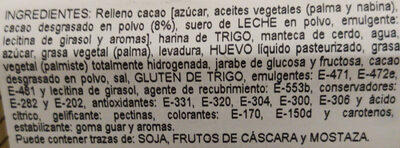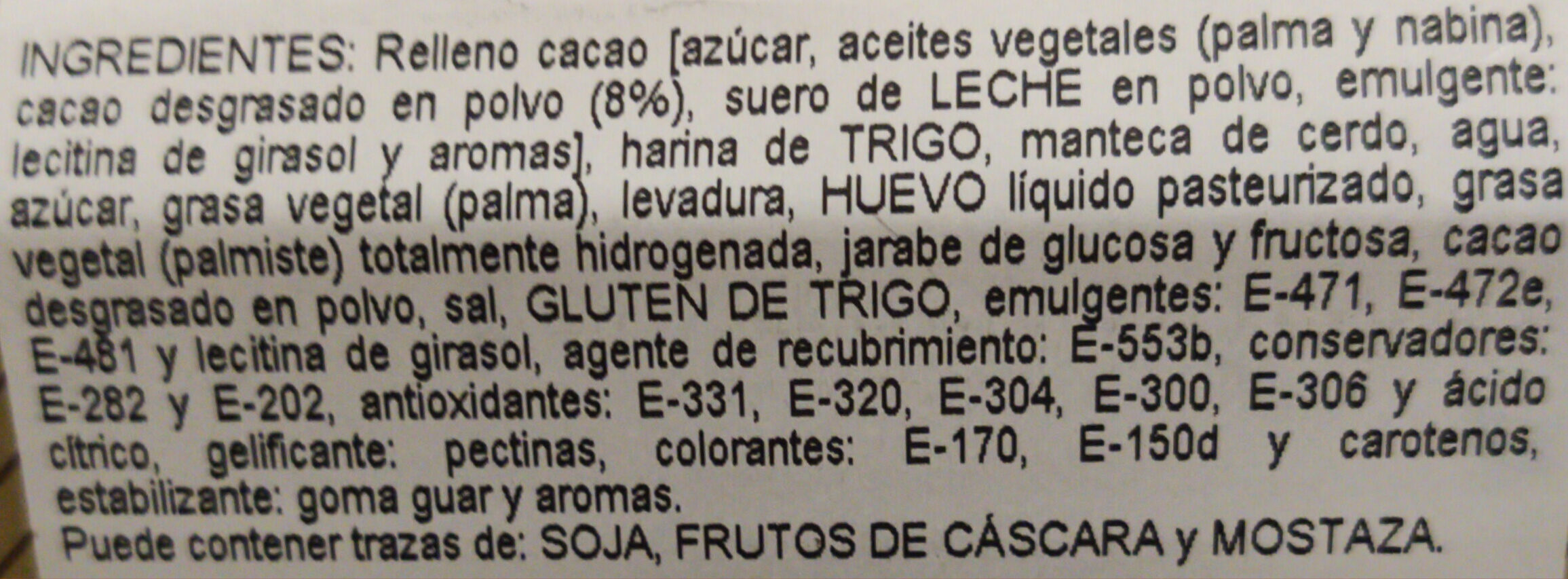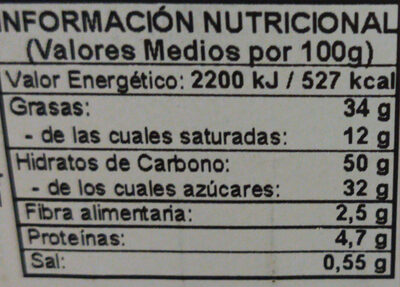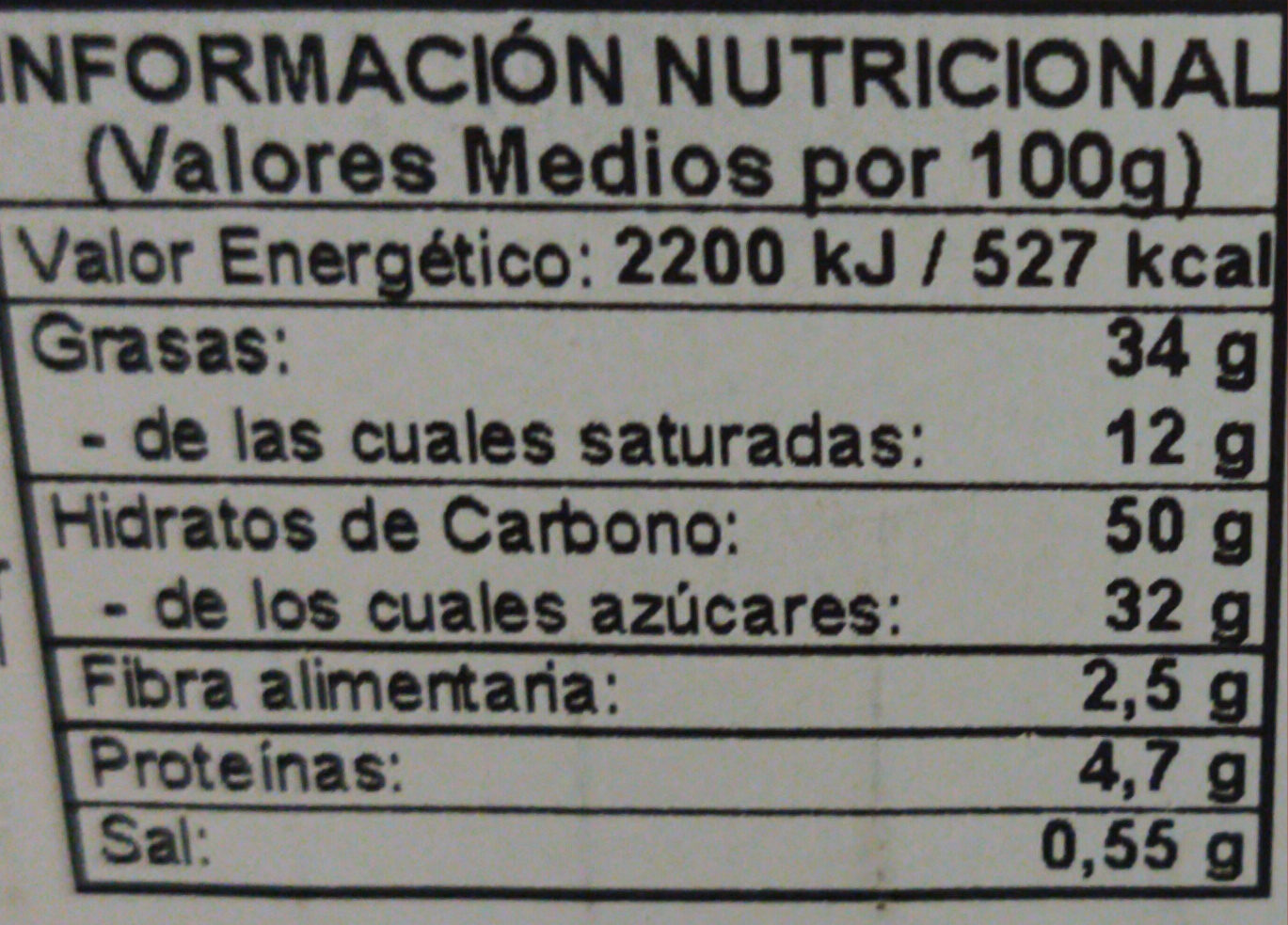Ajuda'ns a fer que la transparència alimentària sigui la norma!
Com a organització sense ànim de lucre, depenem de les vostres donacions per continuar informant els consumidors de tot el món sobre tot allò què mengen.
La revolució alimentària comença amb tu!
Croissant Cacao Viruta - peiron & torrent - 280 g (8)
Croissant Cacao Viruta - peiron & torrent - 280 g (8)
Aquesta pàgina del producte no està completa. Podeu ajudar a completar-la editant-la i afegint-hi més dades a partir de les fotos ja disponibles, o fent-ne més amb l'aplicació de androide o iPhone / iPad. Gràcies!
×
Codi de barres: 8436009678520 (EAN / EAN-13)
Nom comú: Croissant relleno de crema al cacao decorado con virutas al cacao
Quantitat: 280 g (8)
Marques: peiron & torrent
Categories: Snacks, Aperitius dolços, en:Sweet pastries and pies, Brioixeria, en:Chocolate croissant
Etiquetes, certificacions, premis:
Punt verd
Codi de traçabilitat: ES 20.27348/B CE
Botigues: Bonpreu
Països on es va vendre: Espanya
Matching with your preferences
Salut
Ingredients
-
50 ingredients
: Relleno de chocolate [azúcar, aceites vegetales (palma, nabina), cacao desgrasado en polvo (8%), suero de LECHE en polvo, emulgente: lecitina de girasol y aromas], harina de TRIGO, manteca de cerdo, agua, azúcar, grasa vegetal (palma), levadura, HUEVO líquido pasteurizado, grasa vegetal totalmente hidrogenada (palmiste), jarabe de glucosa y fructosa, cacao desgrasado en polvo, sal, GLUTEN DE TRIGO, emulgentes: E-471, E-472e, E-481 y lecitina de girasol, agente de recubrimiento: E-553b, conservadores: E-282 y E-202, antioxidantes: E-331, E-320, E-304, E-300, E-306 y ácido citrico, gelificante: pectinas, colorantes: E-170, E-150d y carotenos, estabilizante: goma guar y aromas.Al·lèrgens: en:Eggs, en:Gluten, en:MilkRastres: en:Mustard, en:Nuts, en:Soybeans
Processament d'aliments
-
Aliments ultra processats
Elements que indiquen que el producte està al grup 4 - Aliments i begudes ultraprocessats:
- Additiu: E150d
- Additiu: E170 - Carbonats de calci
- Additiu: E322 - Lecitines
- Additiu: E412 - Goma de guar
- Additiu: E440 - Pectina
- Additiu: E471 - Monoglicèrids i diglicèrids d'àcids grassos
- Additiu: E472e - Èsters monoacetil i diacetil tartàrics de monoglicèrids i diglicèrids d'àcids grassos
- Additiu: E481 - Estearoïl-2-lactilat de sodi
- Ingredient: Color
- Ingredient: Emulsionant
- Ingredient: Aromes
- Ingredient: Gelificant
- Ingredient: Agent de recobriment
- Ingredient: Glucosa
- Ingredient: Gluten
- Ingredient: Hydrogenated fat
- Ingredient: Sèrum de llet
Els productes alimentaris es classifiquen en 4 grups segons el seu grau de processament:
- Aliments no processats o mínimament processats
- Ingredients culinaris processats
- Aliments processats
- Aliments ultra processats
La determinació del grup es fa en funció de la categoria del producte i dels ingredients que conté.
Additius
-
E170 - Carbonats de calci
Calcium carbonate: Calcium carbonate is a chemical compound with the formula CaCO3. It is a common substance found in rocks as the minerals calcite and aragonite -most notably as limestone, which is a type of sedimentary rock consisting mainly of calcite- and is the main component of pearls and the shells of marine organisms, snails, and eggs. Calcium carbonate is the active ingredient in agricultural lime and is created when calcium ions in hard water react with carbonate ions to create limescale. It is medicinally used as a calcium supplement or as an antacid, but excessive consumption can be hazardous.Origen: Wikipedia (Anglès)
-
E202 - Sorbat de potassi
Potassium sorbate: Potassium sorbate is the potassium salt of sorbic acid, chemical formula CH3CH=CH−CH=CH−CO2K. It is a white salt that is very soluble in water -58.2% at 20 °C-. It is primarily used as a food preservative -E number 202-. Potassium sorbate is effective in a variety of applications including food, wine, and personal-care products. While sorbic acid is naturally occurring in some berries, virtually all of the world's production of sorbic acid, from which potassium sorbate is derived, is manufactured synthetically.Origen: Wikipedia (Anglès)
-
E282 - Propanoat de calci
Calcium propanoate: Calcium propanoate or calcium propionate has the formula Ca-C2H5COO-2. It is the calcium salt of propanoic acid.Origen: Wikipedia (Anglès)
-
E304 - Èster d'àcids grassos d'àcid ascòrbic
Ascorbyl palmitate: Ascorbyl palmitate is an ester formed from ascorbic acid and palmitic acid creating a fat-soluble form of vitamin C. In addition to its use as a source of vitamin C, it is also used as an antioxidant food additive -E number E304-. It is approved for use as a food additive in the EU, the U.S., Canada, Australia, and New Zealand.Ascorbyl palmitate is known to be broken down -through the digestive process- into ascorbic acid and palmitic acid -a saturated fatty acid- before being absorbed into the bloodstream. Ascorbyl palmitate is also marketed as "vitamin C ester".Origen: Wikipedia (Anglès)
-
E320 - Butilhidroxianisol
Butylated hydroxyanisole: Butylated hydroxyanisole -BHA- is an antioxidant consisting of a mixture of two isomeric organic compounds, 2-tert-butyl-4-hydroxyanisole and 3-tert-butyl-4-hydroxyanisole. It is prepared from 4-methoxyphenol and isobutylene. It is a waxy solid used as a food additive with the E number E320. The primary use for BHA is as an antioxidant and preservative in food, food packaging, animal feed, cosmetics, rubber, and petroleum products. BHA also is commonly used in medicines, such as isotretinoin, lovastatin, and simvastatin, among others.Origen: Wikipedia (Anglès)
-
E322 - Lecitines
Lecithin: Lecithin -UK: , US: , from the Greek lekithos, "egg yolk"- is a generic term to designate any group of yellow-brownish fatty substances occurring in animal and plant tissues, which are amphiphilic – they attract both water and fatty substances -and so are both hydrophilic and lipophilic-, and are used for smoothing food textures, dissolving powders -emulsifying-, homogenizing liquid mixtures, and repelling sticking materials.Lecithins are mixtures of glycerophospholipids including phosphatidylcholine, phosphatidylethanolamine, phosphatidylinositol, phosphatidylserine, and phosphatidic acid.Lecithin was first isolated in 1845 by the French chemist and pharmacist Theodore Gobley. In 1850, he named the phosphatidylcholine lécithine. Gobley originally isolated lecithin from egg yolk—λέκιθος lekithos is "egg yolk" in Ancient Greek—and established the complete chemical formula of phosphatidylcholine in 1874; in between, he had demonstrated the presence of lecithin in a variety of biological matters, including venous blood, in human lungs, bile, human brain tissue, fish eggs, fish roe, and chicken and sheep brain. Lecithin can easily be extracted chemically using solvents such as hexane, ethanol, acetone, petroleum ether, benzene, etc., or extraction can be done mechanically. It is usually available from sources such as soybeans, eggs, milk, marine sources, rapeseed, cottonseed, and sunflower. It has low solubility in water, but is an excellent emulsifier. In aqueous solution, its phospholipids can form either liposomes, bilayer sheets, micelles, or lamellar structures, depending on hydration and temperature. This results in a type of surfactant that usually is classified as amphipathic. Lecithin is sold as a food additive and dietary supplement. In cooking, it is sometimes used as an emulsifier and to prevent sticking, for example in nonstick cooking spray.Origen: Wikipedia (Anglès)
-
E322i - Lecitina
Lecithin: Lecithin -UK: , US: , from the Greek lekithos, "egg yolk"- is a generic term to designate any group of yellow-brownish fatty substances occurring in animal and plant tissues, which are amphiphilic – they attract both water and fatty substances -and so are both hydrophilic and lipophilic-, and are used for smoothing food textures, dissolving powders -emulsifying-, homogenizing liquid mixtures, and repelling sticking materials.Lecithins are mixtures of glycerophospholipids including phosphatidylcholine, phosphatidylethanolamine, phosphatidylinositol, phosphatidylserine, and phosphatidic acid.Lecithin was first isolated in 1845 by the French chemist and pharmacist Theodore Gobley. In 1850, he named the phosphatidylcholine lécithine. Gobley originally isolated lecithin from egg yolk—λέκιθος lekithos is "egg yolk" in Ancient Greek—and established the complete chemical formula of phosphatidylcholine in 1874; in between, he had demonstrated the presence of lecithin in a variety of biological matters, including venous blood, in human lungs, bile, human brain tissue, fish eggs, fish roe, and chicken and sheep brain. Lecithin can easily be extracted chemically using solvents such as hexane, ethanol, acetone, petroleum ether, benzene, etc., or extraction can be done mechanically. It is usually available from sources such as soybeans, eggs, milk, marine sources, rapeseed, cottonseed, and sunflower. It has low solubility in water, but is an excellent emulsifier. In aqueous solution, its phospholipids can form either liposomes, bilayer sheets, micelles, or lamellar structures, depending on hydration and temperature. This results in a type of surfactant that usually is classified as amphipathic. Lecithin is sold as a food additive and dietary supplement. In cooking, it is sometimes used as an emulsifier and to prevent sticking, for example in nonstick cooking spray.Origen: Wikipedia (Anglès)
-
E330 - Acid citric
Citric acid: Citric acid is a weak organic acid that has the chemical formula C6H8O7. It occurs naturally in citrus fruits. In biochemistry, it is an intermediate in the citric acid cycle, which occurs in the metabolism of all aerobic organisms. More than a million tons of citric acid are manufactured every year. It is used widely as an acidifier, as a flavoring and chelating agent.A citrate is a derivative of citric acid; that is, the salts, esters, and the polyatomic anion found in solution. An example of the former, a salt is trisodium citrate; an ester is triethyl citrate. When part of a salt, the formula of the citrate ion is written as C6H5O3−7 or C3H5O-COO-3−3.Origen: Wikipedia (Anglès)
-
E331 - Citrats de sodi
Sodium citrate: Sodium citrate may refer to any of the sodium salts of citrate -though most commonly the third-: Monosodium citrate Disodium citrate Trisodium citrateThe three forms of the salt are collectively known by the E number E331. Sodium citrates are used as acidity regulators in food and drinks, and also as emulsifiers for oils. They enable cheeses to melt without becoming greasy.Origen: Wikipedia (Anglès)
-
E412 - Goma de guar
Guar gum: Guar gum, also called guaran, is a galactomannan polysaccharide extracted from guar beans that has thickening and stabilizing properties useful in the food, feed and industrial applications. The guar seeds are mechanically dehusked, hydrated, milled and screened according to application. It is typically produced as a free-flowing, off-white powder.Origen: Wikipedia (Anglès)
-
E440 - Pectina
Pectin: Pectin -from Ancient Greek: πηκτικός pēktikós, "congealed, curdled"- is a structural heteropolysaccharide contained in the primary cell walls of terrestrial plants. It was first isolated and described in 1825 by Henri Braconnot. It is produced commercially as a white to light brown powder, mainly extracted from citrus fruits, and is used in food as a gelling agent, particularly in jams and jellies. It is also used in dessert fillings, medicines, sweets, as a stabilizer in fruit juices and milk drinks, and as a source of dietary fiber.Origen: Wikipedia (Anglès)
-
E471 - Monoglicèrids i diglicèrids d'àcids grassos
Mono- and diglycerides of fatty acids: Mono- and diglycerides of fatty acids -E471- refers to a food additive composed of diglycerides and monoglycerides which is used as an emulsifier. This mixture is also sometimes referred to as partial glycerides.Origen: Wikipedia (Anglès)
-
E481 - Estearoïl-2-lactilat de sodi
Sodium stearoyl lactylate: Sodium stearoyl-2-lactylate -sodium stearoyl lactylate or SSL- is a versatile, FDA approved food additive used to improve the mix tolerance and volume of processed foods. It is one type of a commercially available lactylate. SSL is non-toxic, biodegradable, and typically manufactured using biorenewable feedstocks. Because SSL is a safe and highly effective food additive, it is used in a wide variety of products ranging from baked goods and desserts to pet foods.As described by the Food Chemicals Codex 7th edition, SSL is a cream-colored powder or brittle solid. SSL is currently manufactured by the esterification of stearic acid with lactic acid and partially neutralized with either food-grade soda ash -sodium carbonate- or caustic soda -concentrated sodium hydroxide-. Commercial grade SSL is a mixture of sodium salts of stearoyl lactylic acids and minor proportions of other sodium salts of related acids. The HLB for SSL is 10-12. SSL is slightly hygroscopic, soluble in ethanol and in hot oil or fat, and dispersible in warm water. These properties are the reason that SSL is an excellent emulsifier for fat-in-water emulsions and can also function as a humectant.Origen: Wikipedia (Anglès)
Anàlisi dels ingredients
-
Oli de palma
Ingredients que contenen oli de palma: en:Palm, en:Palm, Palmist
-
No és vegà
Ingredients no vegans: Xerigot en pols, en:Pork fat, Ou liquid, en:Fully hydrogenated vegetable fat
-
No és vegetarià
Ingredients no vegetarians: en:Pork fat
-
Detalls de l'anàlisi dels ingredients
: Relleno de chocolate (azúcar, aceites vegetales (palma, nabina), cacao desgrasado en polvo 8%, suero de LECHE en polvo, emulgente (lecitina de girasol, aromas)), harina de TRIGO, manteca de cerdo, agua, azúcar, grasa vegetal (palma), levadura, HUEVO líquido, grasa vegetal totalmente hidrogenada (palmiste), jarabe de glucosa y fructosa, cacao desgrasado en polvo, sal, GLUTEN DE TRIGO, emulgentes (e471), e472e, e481, lecitina de girasol, agente de recubrimiento (e553b), conservadores (e282), e202, antioxidantes (e331), e320, e304, e300, e306, ácido citrico, gelificante (pectinas), colorantes (e170), e150d, carotenos, estabilizante (goma guar, aromas)- Relleno de chocolate -> en:chocolate-filling - vegan: maybe - vegetarian: yes
- azúcar -> en:sugar - vegan: yes - vegetarian: yes - ciqual_proxy_food_code: 31016
- aceites vegetales -> en:vegetable-oil - vegan: yes - vegetarian: yes - from_palm_oil: maybe
- palma -> en:palm - vegan: yes - vegetarian: yes - from_palm_oil: yes - ciqual_food_code: 16129
- nabina -> en:rapeseed - vegan: yes - vegetarian: yes
- cacao desgrasado en polvo -> en:fat-reduced-cocoa-powder - vegan: yes - vegetarian: yes - ciqual_food_code: 18100 - percent: 8
- suero de LECHE en polvo -> en:whey-powder - vegan: no - vegetarian: maybe
- emulgente -> en:emulsifier
- lecitina de girasol -> en:sunflower-lecithin - vegan: yes - vegetarian: yes
- aromas -> en:flavouring - vegan: maybe - vegetarian: maybe
- harina de TRIGO -> en:wheat-flour - vegan: yes - vegetarian: yes - ciqual_proxy_food_code: 9410
- manteca de cerdo -> en:pork-fat - vegan: no - vegetarian: no - from_palm_oil: maybe - ciqual_food_code: 16530
- agua -> en:water - vegan: yes - vegetarian: yes - ciqual_food_code: 18066
- azúcar -> en:sugar - vegan: yes - vegetarian: yes - ciqual_proxy_food_code: 31016
- grasa vegetal -> en:vegetable-fat - vegan: yes - vegetarian: yes - from_palm_oil: maybe
- palma -> en:palm - vegan: yes - vegetarian: yes - from_palm_oil: yes - ciqual_food_code: 16129
- levadura -> en:yeast - vegan: yes - vegetarian: yes
- HUEVO líquido -> en:liquid-egg - vegan: no - vegetarian: yes - ciqual_food_code: 22000
- grasa vegetal totalmente hidrogenada -> en:fully-hydrogenated-vegetable-fat - vegan: no - vegetarian: maybe - from_palm_oil: maybe
- palmiste -> en:palm-kernel-oil - vegan: yes - vegetarian: yes - from_palm_oil: yes
- jarabe de glucosa y fructosa -> en:glucose-fructose-syrup - vegan: yes - vegetarian: yes - ciqual_food_code: 31077
- cacao desgrasado en polvo -> en:fat-reduced-cocoa-powder - vegan: yes - vegetarian: yes - ciqual_food_code: 18100
- sal -> en:salt - vegan: yes - vegetarian: yes - ciqual_food_code: 11058
- GLUTEN DE TRIGO -> en:wheat-gluten - vegan: yes - vegetarian: yes
- emulgentes -> en:emulsifier
- e471 -> en:e471 - vegan: maybe - vegetarian: maybe - from_palm_oil: maybe
- e472e -> en:e472e - vegan: maybe - vegetarian: maybe - from_palm_oil: maybe
- e481 -> en:e481 - vegan: maybe - vegetarian: maybe - from_palm_oil: maybe
- lecitina de girasol -> en:sunflower-lecithin - vegan: yes - vegetarian: yes
- agente de recubrimiento -> en:glazing-agent
- e553b -> en:e553b - vegan: yes - vegetarian: yes
- conservadores -> en:preservative
- e282 -> en:e282 - vegan: yes - vegetarian: yes
- e202 -> en:e202 - vegan: yes - vegetarian: yes
- antioxidantes -> en:antioxidant
- e331 -> en:e331 - vegan: yes - vegetarian: yes
- e320 -> en:e320 - vegan: yes - vegetarian: yes
- e304 -> en:e304 - vegan: maybe - vegetarian: maybe - from_palm_oil: maybe
- e300 -> en:e300 - vegan: yes - vegetarian: yes
- e306 -> en:e306 - vegan: yes - vegetarian: yes
- ácido citrico -> en:e330 - vegan: yes - vegetarian: yes
- gelificante -> en:gelling-agent
- pectinas -> en:e440a - vegan: yes - vegetarian: yes
- colorantes -> en:colour
- e170 -> en:e170
- e150d -> en:e150d - vegan: yes - vegetarian: yes
- carotenos -> en:e160a - vegan: maybe - vegetarian: maybe - from_palm_oil: maybe
- estabilizante -> en:stabiliser
- goma guar -> en:e412 - vegan: yes - vegetarian: yes
- aromas -> en:flavouring - vegan: maybe - vegetarian: maybe
- Relleno de chocolate -> en:chocolate-filling - vegan: maybe - vegetarian: yes
Nutrició
-
Mala qualitat nutricional
⚠ ️Atenció: la quantitat de fruita, verdura i fruits secs no s'especifica a l'etiqueta, s'ha fet una estimació a partir de la llista d'ingredients: 6Aquest producte no es considera una beguda per al càlcul de la Nutri-Score.
Punts positius: 2
- Proteïnes: 2 / 5 (valor: 4.7, valor arrodonit: 4.7)
- Fibra: 2 / 5 (valor: 2.5, valor arrodonit: 2.5)
- Fruites, verdures, fruits secs i olis de colza/nou/oliva: 0 / 5 (valor: 6.25, valor arrodonit: 6.3)
Punts negatius: 25
- Energia: 6 / 10 (valor: 2190, valor arrodonit: 2190)
- Sucres: 7 / 10 (valor: 32, valor arrodonit: 32)
- Greixos saturats: 10 / 10 (valor: 12, valor arrodonit: 12)
- Sodi: 2 / 10 (valor: 220, valor arrodonit: 220)
Els punts per proteïnes no es compten perquè els punts negatius són més o iguals a 11.
Puntuació nutricional: (25 - 2)
Nutri-Score:
-
Nivells de nutrients
-
Greix en alta quantitat (34%)
Què us cal saber- Un alt consum de greixos, especialment de greixos saturats, pot augmentar el colesterol, que augmenta el risc de patir malalties del cor.
Recomanació: Reduïu el consum de greixos i greixos saturats- Trieu productes amb menys greixos i greixos saturats.
-
Àcid gras saturat en alta quantitat (12%)
Què us cal saber- Un alt consum de greixos, especialment de greixos saturats, pot augmentar el colesterol, que augmenta el risc de patir malalties del cor.
Recomanació: Reduïu el consum de greixos i greixos saturats- Trieu productes amb menys greixos i greixos saturats.
-
Sucre en alta quantitat (32%)
Què us cal saber- Un alt consum de sucre pot provocar augment de pes i càries dental. També augmenta el risc de patir diabetis tipus 2 i malalties cardiovasculars.
Recomanació: Limitau el consum de sucre i de begudes ensucrades- Les begudes ensucrades (com ara refrescos, begudes de fruites i sucs i nèctars de fruites) s'han de limitar tant com sigui possible (no més d'1 got al dia).
- Triau productes amb menor contingut de sucre i reduïu el consum de productes amb sucres afegits.
-
Sal comuna en Quantitat moderada (0.55%)
Què us cal saber- Un alt consum de sal (o sodi) pot provocar un augment de la pressió arterial, que pot augmentar el risc de patir malalties del cor i ictus.
- Moltes persones que tenen hipertensió no ho saben, ja que sovint no en tenen símptomes.
- La majoria de la gent consumeix massa sal (de 9 a 12 grams de mitjana al dia), al voltant del doble del nivell màxim d'ingesta recomanat.
Recomanació: Limitau la ingesta de sal i d'aliments rics en sal- Reduïu la sal que emprau quan cuinau, i no afegiu sal a taula.
- Limiteu el consum d'aperitius salats i trieu productes amb menor contingut de sal.
-
-
Informació nutricional
Informació nutricional Com es ven
per 100 g/100 mlCom es ven
per porció (35 g)Comparat amb: en:Chocolate croissant Energia 2.190 kj
(527 kcal)766 kj
(184 kcal)+11% Greix 34 g 11,9 g +25% Àcid gras saturat 12 g 4,2 g -2% Hidrats de carboni 50 g 17,5 g +2% Sucre 32 g 11,2 g +46% Fiber 2,5 g 0,875 g -4% Proteïna 4,7 g 1,65 g -10% Sal comuna 0,55 g 0,193 g -14% Fruits‚ vegetables‚ nuts and rapeseed‚ walnut and olive oils (estimate from ingredients list analysis) 6,25 % 6,25 %
Entorn
-
Eco-puntuació D - Impacte ambiental alt
El Eco-Score és una puntuació experimental que resumeix els impactes ambientals dels productes alimentaris.→ L'Eco-Score es va desenvolupar inicialment a França i s'està ampliant per a altres països europeus. La fórmula Eco-Score està subjecta a canvis, ja que es millora periòdicament per fer-la més precisa i més adequada per a cada país.Anàlisi del cicle de vida
-
Impacte mitjà dels productes de la mateixa categoria: B (Score: 64/100)
Categoria: Chocolate croissant, puff pastry, from bakery
Categoria: Chocolate croissant, puff pastry, from bakery
- Puntuació ambiental PEF ( petjada ambiental de l'aliment ): 0.39 (com més baixa sigui la puntuació, menor serà l'impacte)
- incloent l'impacte sobre el canvi climàtic: 5.20 kg CO₂ eq/kg del producte
Etapa Impacte Agricultura
52.5 %Processament
39.3 %Empaquetament
4.8 %Transport
3.3 %Distribució
0.2 %Consum
0.0 %
Bonificacions i punts negatius
-
Falta informació sobre l'origen dels ingredients
Punts negatius: -5
⚠ ️ L'origen dels ingredients d'aquest producte no està indicat.
Si estan indicats a l'embalatge, podeu modificar la fitxa del producte i afegir-los.
Si sou el fabricant d'aquest producte, podeu enviar-nos la informació amb la nostra plataforma gratuïta per a productors.
-
Ingredients que amenacen les espècies
Punts negatius: -10
Conté oli de palma
Els boscos tropicals d'Àsia, Àfrica i Amèrica Llatina es destrueixen per crear i ampliar les plantacions de palmera d'oli. La desforestació contribueix al canvi climàtic, i posa en perill espècies com l'orangutan, l'elefant pigmeu i el rinoceront de Sumatra.
-
Falta informació sobre l'embalatge d'aquest producte
Punts negatius: -15
⚠ ️ La informació sobre l'embalatge d'aquest producte no està completada.⚠ ️ Per a un càlcul més precís de l'Eco-Score, podeu modificar la pàgina del producte i afegir-los.
Si sou el fabricant d'aquest producte, podeu enviar-nos la informació amb la nostra plataforma gratuïta per a productors.
Eco-Score per a aquest producte
-
Impacte per a aquest producte: D (Score: 34/100)
Producte: Croissant Cacao Viruta - peiron & torrent - 280 g (8)
Puntuació de l'anàlisi del cicle de vida: 64
Suma de bonificacions i punts negatius: -30
Puntuació final: 34/100
-
Petjada de carboni
-
Equivalent a conduir 2.7 km en un cotxe de gasolina
520 g de CO² per cada 100 g de producte
La xifra d'emissions de carboni prové de la base de dades Agribalyse d'ADEME, per a la categoria: Chocolate croissant, puff pastry, from bakery (Font: Base de dades ADEME Agribalyse)
Etapa Impacte Agricultura
40.2 %Processament
51.3 %Empaquetament
5.5 %Transport
2.9 %Distribució
0.1 %Consum
0.0 %
Empaquetament
-
Falta informació sobre l'embalatge d'aquest producte
⚠ ️ La informació sobre l'embalatge d'aquest producte no està completada.Take a photo of the recycling information Take a photo of the recycling information
Transport
-
Orígens dels ingredients
Falta informació sobre l'origen dels ingredients
⚠ ️ L'origen dels ingredients d'aquest producte no està indicat.
Si estan indicats a l'embalatge, podeu modificar la fitxa del producte i afegir-los.
Si sou el fabricant d'aquest producte, podeu enviar-nos la informació amb la nostra plataforma gratuïta per a productors.Add the origins of ingredients for this product Add the origins of ingredients for this product
Espècies amenaçades
-
Conté oli de palma
Fomenta la desforestació i amenaça espècies com l'orangutan
Els boscos tropicals d'Àsia, Àfrica i Amèrica Llatina es destrueixen per crear i ampliar les plantacions de palmera d'oli. La desforestació contribueix al canvi climàtic, i posa en perill espècies com l'orangutan, l'elefant pigmeu i el rinoceront de Sumatra.
Report a problem
-
Incomplete or incorrect information?
Category, labels, ingredients, allergens, nutritional information, photos etc.
If the information does not match the information on the packaging, please complete or correct it. Open Food Facts is a collaborative database, and every contribution is useful for all.
Fonts de dades
Producte afegit per kiliweb
Última modificació de la pàgina del producte per duhowpi.
La pàgina del producte, també editada per thaialagata, yuka.ZDRNZFM2a1psOEF3cWZBRCswUHMvc05UeTdtWlltK21LYkFMSWc9PQ.












